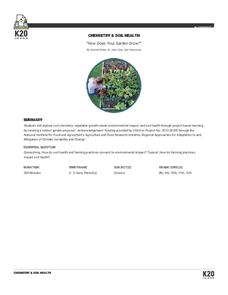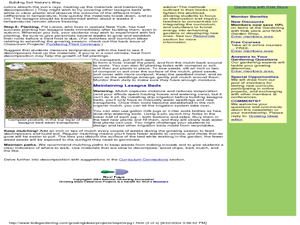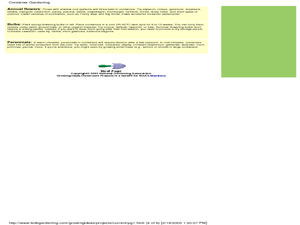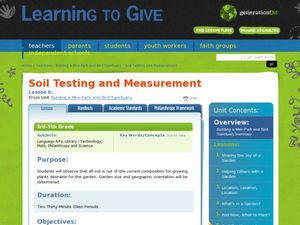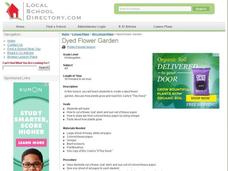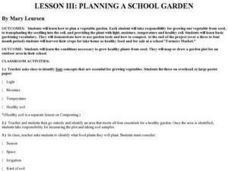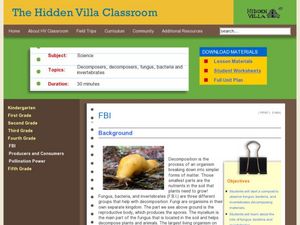K20 LEARN
How Does Your Garden Grow?
Seventy thousand different types of soil exist in the United States alone. Young scientists learn about the importance of soil to the food supply. They test soil for a variety of factors and determine the best place to set up a community...
Curated OER
Building Soil Nature's Way: Exploring decomposition and soil health
Learners explore decomposition and soil health by creating their own garden. For this agriculture lesson, students build a "lasagna garden" with organic matter found in the area and plant perennials native to their region....
Curated OER
Garbage in the Garden
Students create their own compost. In this soil lesson, students fill a bag with waste and soil, in order to create a mini compost bin. Students observe the baggies over a 6 week period, they record their findings and collect data...
Captain Planet Foundation
Fall into Healthy Shapes
Kindergartners identify geometric shapes by planting a fall garden. They start their seeds in containers that have different shapes, and keep track of their plants based on those shapes. This brilliantly designed and incredibly thorough...
Curated OER
The Japanese Garden
Students use the internet to gather information on the Japanese Gardens. They discuss topics with a horticulturist and build a replica of the gardens at their school. They work together to identify different types of plants.
Curated OER
Preparing and Planting the Garden
Young scholars prepare to build and plant a garden. In this service learning lesson, students take all the necessary steps to prepare a community garden for planting and reflect on the experience.
Captain Planet Foundation
Worm Your Way Out of This
How can you provide healthy soil for your garden? Study worms, bacteria, and other microorganisms in a lesson about decomposition and organic compost. After discussing what you know about worms and watching a video, watch what worms do...
Curated OER
Lesson 12: Ho'olaulima: Let's Make a Hawaiian Garden
Second graders grow a classroom garden that acts as a living laboratory for cross-curricular activities. In this classroom garden lesson, 2nd graders follow directions to build and plant a garden that is used to teach math, science, and...
Curated OER
Soil Recipe
Students examine the components of soil. They work together to use different materials to create their own soil. They make their own dirt cake as well.
Curated OER
Building a Butterfly Garden
Students examine the habitat and life cycle of a butterfly. In this early childhood lesson plan, students identify the parts of a butterfly, as well as the stages of the butterfly life cycle. Students also plant a garden in which they...
Curated OER
Gardening in Containers
Students plant a garden. In this gardening lesson, students use containers to plant a garden. This lesson provides a good source of information for teachers who wish to begin their class's own container garden.
Curated OER
Garden In a Glove
Students investigate the concept of seeds and how they can germinate. They obtain seeds and isolate them in a rubber glove before transplanting them into the ground. The lesson includes a graphic organizer for observations or information.
Curated OER
Soil Testing and Measurement
Students prepare their garden plot. In this gardening lesson, students use the Internet or book on plants to make sure the plants they have selected will be able to grow in their garden. The students assess and mark out the garden...
Captain Planet Foundation
Energy Flow in the Garden
How can you tell what an owl has eaten? Study the food chain and flow of energy in an ecosystem by dissecting an owl pellet and noting the bones found inside. Additionally, the instructional activity includes a game about consumers and...
Curated OER
Landscape Garden Makeover
A project-based learning plan focuses on landscapes in the community. After identifying problems, such as dead trees or misplaced automatic sprinklers, learners design solutions, contact local organizations to fix the problems, and do...
Curated OER
Garden Starters
Students grow their own gardens. In this planting lesson, students use egg cartons to start their own gardens by planting and caring for seeds. A game, a song, a craft, and a recipe are all included with the lesson to complement the theme.
Curated OER
Soil Profile
Fourth graders research soil layers and create a soil profile in a jar. In this soil profile lesson, 4th graders working in groups, research a given layer of soil, make a 3-5 minute presentation to the class, and complete a...
Curated OER
Make Your Own Garden
Students explore gardening. In this Quiet in the Garden lesson plan, students read the picture book by Aliki and extend the lesson by taking part in up to 5 hands-on activities.
Curated OER
Dyed Flower Garden
Students create a dyed flower garden. In this art lesson, students read the book Tiny Seed and cut flowers out of tissue paper to create a paper flower garden.
Curated OER
Planting Phil's Garden
Students explore gardening. In this agriculture lesson, students plan and plant seeds according to the procedure modeled by a "master gardener." Flowers are distributed at a local retirement home.
Curated OER
How to Grow a Sunflower Plant
Young scholars explore botany by conducting a sunflower growth experiment. In this plant life lesson, students identify the anatomy of a sunflower plant and the essential nutrients it requires to grow. Young scholars utilize compost,...
Curated OER
Planning A School Garden
Students discover how to plan a vegetable garden. Each student take responsibility for growing one vegetable from seed, to transplanting the seedling into the soil, and providing the plant with light, moisture, temperature and healthy soil.
Curated OER
FBI
Fourth graders experiment with compost. In this Science activity, 4th graders begin a worm compost as well as an outdoor compost. Students discuss decomposition.
Curated OER
Do They Grow Up or Down?
Students keep a garden journal after planting a garden and discuss environmental stresses put upon the garden for growth. In this garden lesson plan, students plant the plants differently from one another and observe the outcomes.
